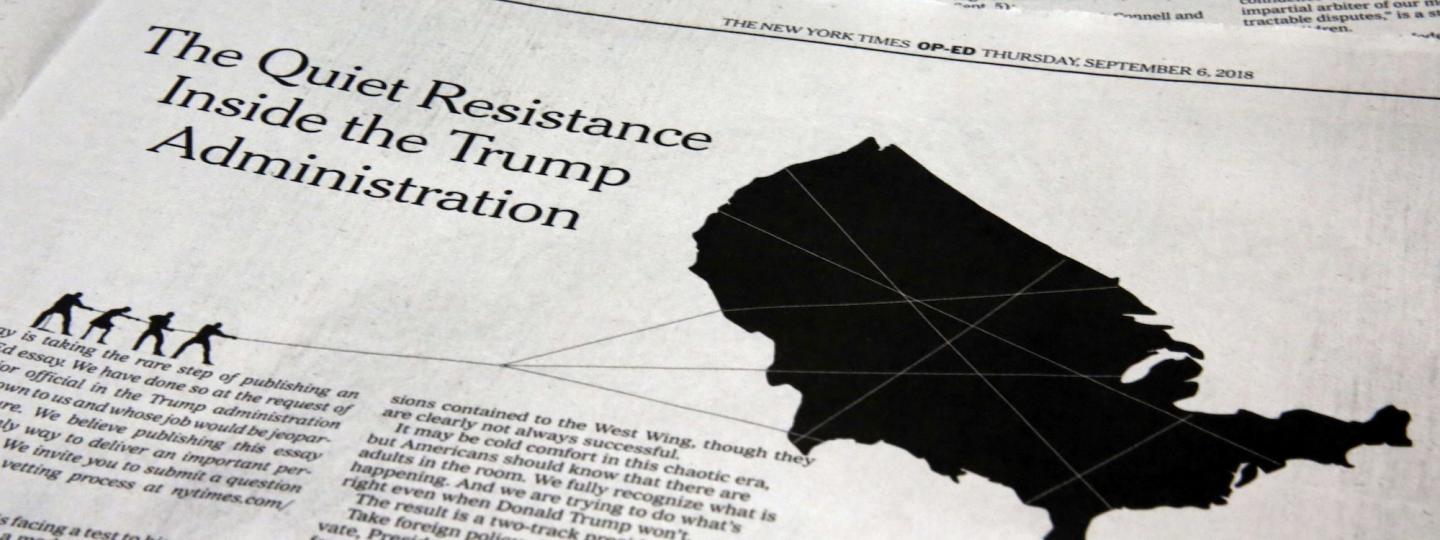"Flying off the handle" is a cliché that hearkens back to a time when axes weren’t always well-made. Sometimes, the lethal head would …
When the New York Times published an anonymous op-ed from a “senior administration official” who works for President Donald Trump, it let loose a projectile that is going to land somewhere.
So let’s take a look at the possible ramifications.
Will this impact the public’s trust in journalism? That depends on your political viewpoint. A recent study suggests that public trust in journalism is on the rise after bottoming out. But there’s still a deep divide depending on political affiliation. Republicans report distrust in the generic media at a much higher rate than Democrats. Trust in national medial outlets like the New York Times is significantly lower than trust in local media. The Poynter Media Trust Survey found 76 percent of Americans across the political spectrum have "a great deal" or "a fair amount" of trust in their local television news, and 73 percent have similar confidence in local newspapers. Only 55 percent reported trust in national networks and 59 percent in national newspapers. This op-ed will certainly exacerbate the gulf in trust between national and local, as well as between Republicans and Democrats. Trump predictably dismissed it as a “phony source.” Trump critics will reward the Times for publishing the piece.
Have the standards for anonymous sourcing changed? We in the profession used to suggest that anonymous sources should be rare and only for the most important stories. It's debatable if this meets that standard, or if an anonymous opinion piece should be held to the same standard. (Maybe it should be a higher threshold?) This essay makes some spicy claims like, "Given the instability many witnessed, there were early whispers within the cabinet of invoking the 25th Amendment, which would start a complex process for removing the president." If this had been a news story, we would have insisted on more details.Whispers to whom? This author is pushing the government toward a grave and critical outcome. The public has an interest in knowing all it can about the forces behind such tumult. It would be helpful if the Times disclosed whether and how it vetted the writer's claims.
Why do an op-ed instead of a story? Surely the Times could have reported a news story citing dozens of sources who are undermining President Trump in small and large ways. But that misses the point. Bob Woodward’s book documents that people in the White House are trying to minimize the harm President Trump can cause. This piece, which was in the works for days, brings more context to that claim. Its value is that it takes us inside the moral reasoning of someone who does not believe in President Trump, yet shows up to work every morning.
Does an anonymous piece change the way we have a democratic discussion? Google the word “lodestar,” and you will get a lesson in unintended consequences. Whenever we keep a source in the shadows, we spread possible agency onto the innocents. Was it Vice President Mike Pence? Was it his speechwriter? Or was it a clever diversion? Until the source is revealed, numerous people will suffer under the cloud of suspicion.
Can you even have a discussion about the implications of this piece if we don’t know who is behind it? Only if you trust the New York Times’ judgment. As Ari Fleischer, President George W. Bush’s press secretary, pointed out in a series of tweets: “It's impossible to evaluate how important it is without knowing how high up the author is. There are hundreds of people at the WH who think they're 'senior' officials. If this is a cabinet secretary, it's a problem.”
Did the NYTimes think they could protect this author? Certainly the editors on the op-ed page discussed with the author the possibility that he or she would be outed. And if this author truly is a “senior White House official,” he or she knew the possible ramifications. It’s safe to say that everybody’s an adult here. Trump’s “TREASON” tweet probably wasn’t surprising. Treason is defined as giving aid to the enemy. It is the most serious of federal crimes, even punishable by death.
Given who Trump defines as his enemy, it’s not surprising he would call this op-ed treason. It’s not the first time President Trump has mixed up his Constitutional priorities. Yet, the First Amendment protection of the press comes with great responsibility: to hold the powerful accountable, to be responsive to critics and to take every measure to ensure the truth is told. As the New York Times reveals more about this decision, we'll be better able to judge whether they are upholding their end of this bargain.







